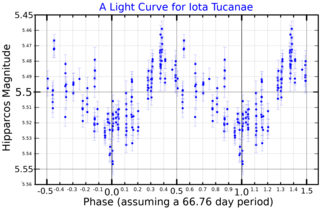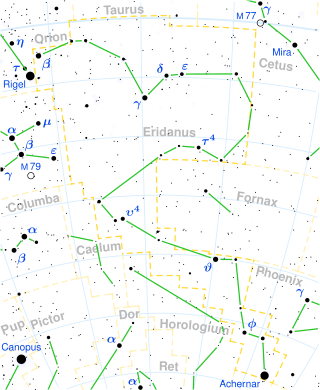Related Research Articles

60 Sagittarii is a suspected binary star system in the southern constellation of Sagittarius. It has the Bayer designation A Sagittarii, while 60 Sagittarii is the Flamsteed designation. This naked-eye object forms the northwest corner of the asterism called the Terebellum and, with an apparent magnitude of approximately 4.84, it is the dimmest of the four stars in the Terebellum. It is located 379 light-years from the Sun, based on parallax, but is moving closer with a radial velocity of −51 km/s.
Epsilon Telescopii, Latinized from ε Telescopii, is a solitary, orange-hued star in the southern constellation of Telescopium. It is visible to the naked eye with an apparent visual magnitude of +4.53. Based upon an annual parallax shift of 7.80 mas as seen from Earth, it is located roughly 410 light years from the Sun, give or take 20 light years.

θ Trianguli Australis, Latinized as Theta Trianguli Australis, is a single star in the southern constellation of Triangulum Australe. It is visible to the naked eye as a dim, yellow-hued star with an apparent visual magnitude of +5.50. The star is located about 334 light years from the Sun based on parallax, and is drifting further away with a radial velocity of +10 km/s.

Iota Tucanae is a solitary star in the southern constellation of Tucana. Based upon an annual parallax shift of 10.72 mas as seen from Earth, it is located around 304 light years from the Sun. With an apparent visual magnitude of +5.33, it is faintly visible to the naked eye.
HD 94510 is a single star in the southern constellation of Carina, positioned near the northern constellation border with Vela. It has the Bayer designation u Carinae; HD 94520 is the identifier from the Henry Draper Catalogue. This object has an orange hue and is visible to the naked eye with an apparent visual magnitude that fluctuates around +3.78. The star is located at a distance of 95 light-years from the Sun based on parallax, and is drifting further away with a radial velocity of +8 km/s.
HD 96566 is a single star in the southern constellation of Carina. It has the Bayer designation z1 Carinae; HD 96566 is the identifier from the Henry Draper Catalogue. This object has a yellow hue and is visible to the naked eye with an apparent visual magnitude of +4.62. The star is located at a distance of approximately 376 light years from the Sun based on parallax, but is drifting closer with a radial velocity of −1 km/s. It has an absolute magnitude of −0.81.
ι Crucis, Latinized as Iota Crucis, is a wide double star in the southern constellation of Crux. It is visible to the naked eye as a faint, orange-hued point of light with an apparent visual magnitude of 4m.69. This object is located 125 light-years from the Sun, based on parallax, and is drifting further away with a radial velocity of +7.5 km/s.

Beta Mensae, Latinized from β Mensae, is the third-brightest star in the constellation of Mensa. Despite this, it is only faintly visible to the naked eye, appearing as a dim, yellow-hued point of light with an apparent visual magnitude of 5.31. The star is positioned near the southwest edge of the Large Magellanic Cloud, but it does not form part of this much more distant satellite galaxy. Based upon an annual parallax shift of just 4.11 mas as seen from the Earth, the star is located at a distance of roughly 790 light years from the Sun. It is moving closer with a heliocentric radial velocity of −11 km/s.

Eta Reticuli, Latinized from η Reticuli, is a solitary star in the southern constellation of Reticulum. With an apparent visual magnitude of 5.22, it is faintly visible to the naked eye on a dark night. Based upon an annual parallax shift of 8.48 mas, it is located at a distance of roughly 385 light years from the Sun. It may be a member of the high-velocity Zeta Herculis Moving Group of stars that share a common motion through space.

Delta Piscis Austrini, Latinized from δ Piscis Austrini, is a yellow-hued star in the southern constellation of Piscis Austrinus. It is visible to the naked eye with an apparent visual magnitude of +4.175. There is a magnitude 9.86 common proper motion companion located at an angular separation of 5.2 arc seconds – the pair most likely form a binary star system. Based upon an annual parallax shift of 18.9796 mas as seen from the Gaia satellite, Delta Piscis Austrini is located 172 ± 2 light-years from the Sun.
HD 123569 is a single star in the southern constellation of Centaurus, positioned near the eastern constellation border with Lupus. This object has a yellowish hue and is visible to the naked eye with an apparent visual magnitude of 4.74. It is located at a distance of approximately 176 light years from the Sun based on parallax, and it has an absolute magnitude of +1.00. The star is drifting closer with a radial velocity of −17 km/s. O. J. Eggen flagged this star as a member of the Hyades Supercluster.

HD 24160 is a single star in the equatorial constellation of Eridanus. It is visible to the naked eye with an apparent visual magnitude of 4.17. The distance to HD 24160 can be estimated from its annual parallax shift of 15.0 mas, yielding a separation of 217 light years. It is moving further from the Earth with a heliocentric radial velocity of +2 km/s. This object is a coronal member of the Ursa Major Moving Group of stars that share a common motion through space.

HD 12055 is a candidate astrometric binary star system in the southern constellation of Phoenix, near the eastern constellation border with Eridanus. It is yellow in hue and is visible to the naked eye with an apparent visual magnitude of 4.82. The system is located at a distance of approximately 249 light years from the Sun based on parallax, and is drifting further away with a radial velocity of +13 km/s.
ν Gruis, Latinised as Nu Gruis, is a solitary, yellow-hued star in the southern constellation of Grus. It is visible to the naked eye with an apparent visual magnitude of 5.47. The distance to this star, as determined using an annual parallax shift of 11.6 mas as seen from the Earth, is 280 light years. It is drifting further away with a heliocentric radial velocity of +11 km/s.
λ Pictoris, Latinised as Lambda Pictoris, is a solitary, orange-hued star in the southern constellation of Pictor. It is visible to the naked eye, having an apparent visual magnitude of +5.29. With an annual parallax shift of 8.71 mas as seen from the Earth, it is located around 374 light-years from the Sun. At the estimated age of 2.24 billion years old, it is an evolved K-type giant star with a stellar classification of K0/1 III. Lambda Pictoris has 2.2 times the mass of the Sun and is radiating 112 times the Sun's luminosity from its photosphere at an effective temperature of 4,581 K.
γ Horologii, Latinised as Gamma Horologii, is a solitary star in the southern constellation of Horologium. It is just bright enough to be visible to the naked eye as a dim, yellow-hued point of light with an apparent visual magnitude of +5.74. This object is located at a distance of 183 light years from the Sun, but is drifting closer with a radial velocity of −19 km/s.
ξ Mensae, Latinized as Xi Mensae, is a single star in the southern circumpolar constellation of Mensa. It has a yellow-orange hue and is just barely visible to the naked eye as a dim point of light with an apparent visual magnitude of 5.84. This object is located about 366 light years away from the Sun based on parallax, but is drifting closer with a radial velocity of −5 km/s.
HD 55151 is a solitary star located in the circumpolar constellation Volans. With an apparent magnitude of 6.47, it is near the limit of naked eye visibility. The star is located 512 light years away from the Solar System, but is drifting closer with a heliocentric radial velocity of -13 km/s.
HD 22676 is a solitary star in the southern circumpolar constellation Mensa. It has an apparent magnitude of 5.67, making it faintly visible to the naked eye and is currently located at a distance of 333 light years. However, it is recceding from the sun with a radial velocity of 18.4 km/s.
HD 1032 is a solitary star in the southern circumpolar constellation Octans. It is faintly visible to the naked eye with an apparent magnitude of 5.77 and is estimated to be 850 light years away from the Solar System based on parallax measure. However, it is receding with a heliocentric radial velocity of 4 km/s.
References
- 1 2 3 4 5 6 7 8 9 10 11 12 13 14 Brown, A. G. A.; et al. (Gaia collaboration) (August 2018). "Gaia Data Release 2: Summary of the contents and survey properties". Astronomy & Astrophysics . 616. A1. arXiv: 1804.09365 . Bibcode: 2018A&A...616A...1G . doi: 10.1051/0004-6361/201833051 . Gaia DR2 record for this source at VizieR.
- 1 2 3 4 Anderson, E.; Francis, Ch. (2012), "XHIP: An extended hipparcos compilation", Astronomy Letters, 38 (5): 331, arXiv: 1108.4971 , Bibcode:2012AstL...38..331A, doi:10.1134/S1063773712050015, S2CID 119257644
- 1 2 Houk, Nancy; Cowley, A. P. (1979), Michigan catalogue of two-dimensional spectral types for the HD stars, vol. 1, Ann Arbor, Michigan: Dept. of Astronomy, University of Michigan, Bibcode:1978mcts.book.....H
- 1 2 3 4 Luck, R. Earle (2015), "Abundances in the Local Region. I. G and K Giants", Astronomical Journal, 150 (3), 88, arXiv: 1507.01466 , Bibcode:2015AJ....150...88L, doi:10.1088/0004-6256/150/3/88, S2CID 118505114.
- 1 2 3 Alves, S.; et al. (April 2015), "Determination of the spectroscopic stellar parameters for 257 field giant stars", Monthly Notices of the Royal Astronomical Society, 448 (3): 2749–2765, arXiv: 1503.02556 , Bibcode:2015MNRAS.448.2749A, doi:10.1093/mnras/stv189.
- ↑ "HD 81101". SIMBAD . Centre de données astronomiques de Strasbourg . Retrieved 2020-01-26.
- ↑ Eggleton, P. P.; Tokovinin, A. A. (September 2008), "A catalogue of multiplicity among bright stellar systems", Monthly Notices of the Royal Astronomical Society , 389 (2): 869–879, arXiv: 0806.2878 , Bibcode:2008MNRAS.389..869E, doi:10.1111/j.1365-2966.2008.13596.x, S2CID 14878976.
- ↑ Bailer-Jones, C. A. L. (March 2015), "Close encounters of the stellar kind", Astronomy & Astrophysics, 575: 13, arXiv: 1412.3648 , Bibcode:2015A&A...575A..35B, doi:10.1051/0004-6361/201425221, S2CID 59039482, A35.
- ↑ Eggen, Olin J. (April 1989), "Large and Kinematically Unbiased Samples of G- and K-Type Stars. IV. Evolved Stars of the Old Disk Population", Publications of the Astronomical Society of the Pacific, 101: 366, Bibcode:1989PASP..101..366E, doi:10.1086/132442, S2CID 121365843.